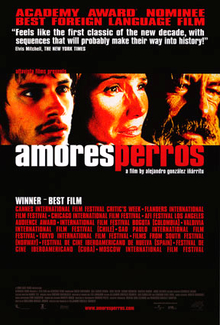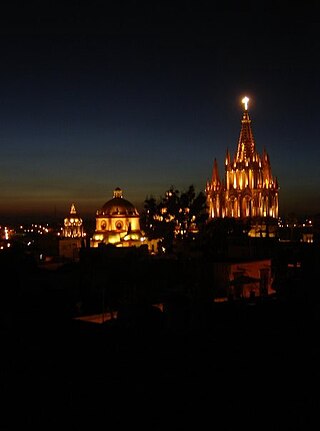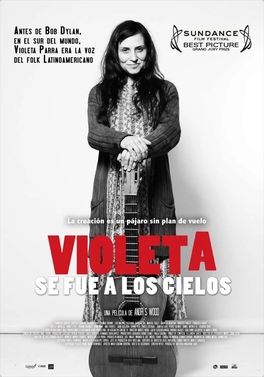Related Research Articles

Mexican cinema dates to the late nineteenth century during the rule of President Porfirio Díaz. Seeing a demonstration of short films in 1896, Díaz immediately saw the importance of documenting his presidency in order to present an ideal image of it. With the outbreak of the Mexican Revolution in 1910, Mexican and foreign makers of silent films seized the opportunity to document its leaders and events. From 1915 onward, Mexican cinema focused on narrative film.

Amores perros is a 2000 Mexican psychological drama film directed by Alejandro González Iñárritu and written by Guillermo Arriaga, based on a story by them both. Amores perros is the first installment in González Iñárritu's "Trilogy of Death", succeeded by 21 Grams and Babel. It makes use of the multi-narrative hyperlink cinema style and features an ensemble cast. The film is constructed as a triptych: it contains three distinct stories connected by a car crash in Mexico City. The stories centre on a teenager in the slums who gets involved in dogfighting; a model who seriously injures her leg; and a mysterious hitman. The stories are linked in various ways, including the presence of dogs in each of them.

Gael García Bernal is a Mexican actor and filmmaker. He is known for his performances in the films Bad Education (2004), The Motorcycle Diaries (2004), Amores perros (2000), Y tu mamá también (2001), Babel (2006), Coco (2017), and Old (2021), for his role as the titular character in the Marvel Cinematic Universe television special Werewolf by Night (2022), and for his role as Rodrigo de Souza in the series Mozart in the Jungle (2014–18).

Alejandro González Iñárritu is a Mexican filmmaker. He is primarily known for making modern psychological drama films about the human condition. His projects have garnered critical acclaim and numerous accolades including four Academy Awards with a Special Achievement Award, three Golden Globe Awards, three BAFTA Awards, two Directors Guild of America Awards. His most notable films include Amores perros (2000), 21 Grams (2003), Babel (2006), Biutiful (2010), Birdman (2014), The Revenant (2015), and Bardo (2022).

Cinema of Colombia refers to film productions made in Colombia, or considered Colombian for other reasons. Colombian cinema, like any national cinema, is a historical process with industrial and artistic aspects.

Guillermo Arriaga Jordán is a Mexican novelist, screenwriter, director and producer. Self-defined as "a hunter who works as a writer," he is best known for his Academy Award for Best Original Screenplay and BAFTA Award for Best Original Screenplay nominations for Babel and his screenplay for The Three Burials of Melquiades Estrada, which received the 2005 Cannes Best Screenplay Award.
Women's cinema primarily describes cinematic works directed by women filmmakers. The works themselves do not have to be stories specifically about women, and the target audience can be varied.

Selton Figueiredo Mello is a Brazilian actor, voice actor, screenwriter, producer, editor and director. Since his childhood, he acted on TV shows. Now he works on TV, movies and theater. Throughout his career, he developed a strong and solid experience in cinema, producing and directing movies and videoclips, and being publicly and critically acclaimed for it. The actor hosted Tarja Preta, a TV show about culture and independent movies, from 2004 until 2008.

While the Peruvian film industry has not been nearly as prolific as that of some other Latin American countries, such as Mexico or Argentina, some Peruvian movies produced enjoyed regional success. Historically, the cinema of Peru began in Iquitos in 1932 by Antonio Wong Rengifo because of the rubber boom and the intense arrival of foreigners with technology to the city, and thus continued an extensive, unique filmography, with a different style than the films made in the capital, Lima.

Nuevo Cine Mexicano, also referred to as New Mexican Cinema is a Mexican film movement started in the early 1990s. Filmmakers, critics, and scholars consider Nuevo Cine Mexicano a "rebirth" of Mexican cinema because of the production of higher-quality films. This rebirth led to high international praise as well as box-office success, unseen since the golden age of Mexican cinema of the 1930s to 1960s. The quality of Mexican films suffered in the decades following the golden age due in part to Mexican audiences watching more overseas films, especially Hollywood productions. This resulted in the rise of infamous Mexican genres such as Luchador films, sexicomedias and ultimately the low-budget direct-to-video Mexploitation film.

The Guanajuato International Film Festival or GIFF is an annual international film festival, held since 1998. It is held during the final week of July in San Miguel de Allende and Guanajuato City, Mexico. GIFF was formerly known as Expresión en Corto International Film Festival.

Ánima Estudios, S.A.P.I. de C.V. is a Mexican animation studio and family entertainment company founded in 2002 by Fernando De Fuentes S. and Jose C. Garcia De Letona, the studio is best known for producing El Chavo Animado, Top Cat: The Movie, the Leyendas franchise, and Cleo & Cuquín.
The Goya Award for Best Ibero-American Film, formerly the Goya Award for Best Spanish Language Foreign Film and the Goya Award for Best Hispanic American Film, is one of the Goya Awards, Spain's principal national film awards. The category has been presented ever since the first edition of the Goya Awards with the exception of the third edition where it was not awarded. Carlos Sorín's A King and His Movie was the first winner of this award representing Argentina.

Chilean cinema refers to all films produced in Chile or made by Chileans. It had its origins at the start of the 20th century with the first Chilean film screening in 1902 and the first Chilean feature film appearing in 1910. The oldest surviving feature is El Húsar de la Muerte (1925), and the last silent film was Patrullas de Avanzada (1931). The Chilean film industry struggled in the late 1940s and in the 1950s, despite some box-office successes such as El Diamante de Maharajá. The 1960s saw the development of the "New Chilean Cinema", with films like Three Sad Tigers (1968), Jackal of Nahueltoro (1969) and Valparaíso mi amor (1969). After the 1973 military coup, film production was low, with many filmmakers working in exile. It increased after the end of the Pinochet regime in 1989, with occasional critical and/or popular successes such as Johnny cien pesos (1993), Historias de Fútbol (1997) and Gringuito (1998).

The cinema of Venezuela is the production and industry of filmmaking in Venezuela. Venezuelan cinema has been characterised from its outset as propaganda, partially state-controlled and state-funded, commercial cinema. The nation has seen a variety of successful films, which have reaped several international awards. Still, in terms of quality, it is said that though "we can point to specific people who have made great films in Venezuela [and] a couple of great moments in the history of Venezuelan cinema, [...] those have been exceptions". In the 21st century, Venezuelan cinema has seen more independence from the government, but has still been described as recently as 2017 to be at least "influenced" by the state.
The New England Festival of Ibero American Cinema is a film festival that takes place annually in the cities of Providence, Rhode Island, and New Haven, Connecticut, in the United States. It is the largest Latin American cinema festival in the region of New England. Held in early fall in Providence and New Haven, the festival aims to become the premier showcase for new works from Latin American and Ibero American filmmakers. The festival comprises competitive sections for feature films, documentaries and short films. A group of non-competitive showcase sections, including Desde Cuba: New Cinema and Panorama are also an important part of the festival. Panels, Art Exhibits and Discussions are the focus of the festival which every year invites and hosts Spanish and Latin American filmmakers to interact with Providence and New England audiences.

Violeta Went to Heaven is a 2011 Chilean biographical drama film about singer and folklorist Violeta Parra, directed by Andrés Wood. The film is based on a biography by Ángel Parra, Violeta's son with Luis Cereceda Arenas. He collaborated on the film.
The Biarritz Festival Latin America is an international film festival held annually in the French city of Biarritz, since 1979 to promote the Latin American cinema and culture with the French people and offer opportunities to distribution or coproductions to Latin American films.

Latin American television awards are or were given by several organizations for contributions in various fields of television in Latin America.
References
- ↑ "Maria Candelaria".
- ↑ "Festival de Cannes: O Pagador de Promessas". festival-cannes.com. Archived from the original on 2011-09-15. Retrieved 2009-02-23.
- ↑ "Centro Virtual Isaacs - Carlos Mayolo y el innolvidable Caliwood". Archived from the original on 2011-07-07. Retrieved 2010-07-04. Carlos Mayolo y el innolvidable Caliwood (in Spanish)
- ↑ "Wild Tales (15)". British Board of Film Classification. Retrieved 3 May 2022.
- ↑ "Perú: PwC: industria cinematográfica crecerá 5,92% anual en Perú al 2023 | NOTICIAS EL COMERCIO PERÚ". El Comercio Perú (in Spanish). 2019-09-09. Retrieved 2020-08-24.
- ↑ Hopewell, John (2018-11-27). "Ventana Sur's Animation! Marks Latin America's Toon Surge". Variety. Retrieved 2020-08-25.
- ↑ García, Marta (2017-05-11). "The New Wave Of Latin American Animated Features: 10 Films To Watch For". Cartoon Brew. Retrieved 2020-08-25.
Further reading
- Timothy Barnard and Peter Rist (eds.): South American Cinema: A Critical Filmography 1915-1994, Austin: University of Texas Press, 1996
- Julianne Burton (ed.): Cinema and Social Change in Latin America. Conversations with Filmmakers, Austin: University of Texas Press, 1986
- Julianne Burton (ed.): The Social Documentary in Latin America, Pittsburgh: University of Pittsburgh Press, 1990
- Alberto Elena, Marina Diaz Lopez (eds.): The Cinema of Latin America (24 Frames), Columbia Univ Press, 2003, ISBN 1-903364-83-3
- Miriam Haddu, Joanna Page (eds.): Visual Synergies in Fiction and Documentary Film from Latin America, Palgrave Macmillan, 2009
- Stephen M. Hart. A Companion to Latin American Film, Tamesis, 2004
- John King: Magical Reels: A History of Cinema in Latin America, New edition, Verso, 2000, ISBN 1-85984-233-X
- Michael T. Martin (ed.): New Latin American Cinema, Volume 1: Theories, Practices, and Transcontinental Articulations, Wayne State University Press, 1997
- Michael T. Martin (ed.): New Latin American Cinema, Volume 2: Studies of National Cinemas, Wayne State University Press, 1997
- Isabel Maurer Queipo (ed.): Directory of World Cinema: Latin America, intellectbooks, 2013, ISBN 9781841506180
- Zuzana M. Pick. The New Latin American Cinema: A Continental Project, University of Texas Press, 1993
- Paul A. Schroeder Rodriguez. Latin American Cinema: A Comparative History, University of California Press, 2016
- Ronald Schwartz. Latin American Films, 1932-1994: A Critical Filmography, McFarland, 1997
- Deborah Shaw (ed.): Contemporary Latin American Cinema: Breaking Into the Global Market, Rowman & Littlefield, 2007, ISBN 0-7425-3915-6
- Donald F. Stevens (ed.): Based on a True Story: Latin American History at the Movies, Scholarly Resources, 1997, ISBN 0-8420-2781-5
- Ann Marie Stock (ed.): Framing Latin American Cinema: Contemporary Critical Perspectives, University of Minnesota Press, 1997
